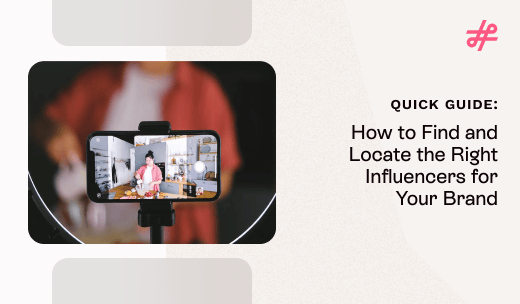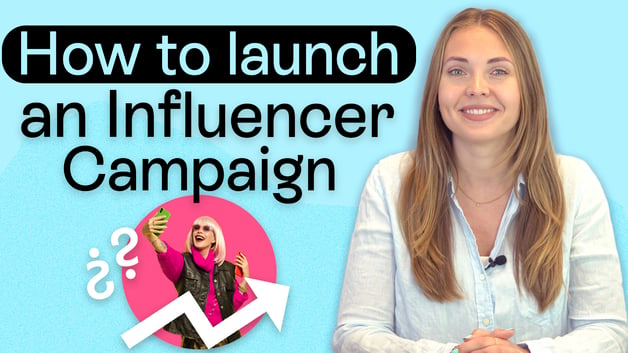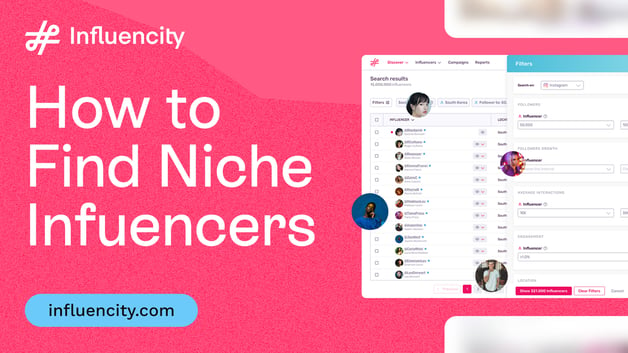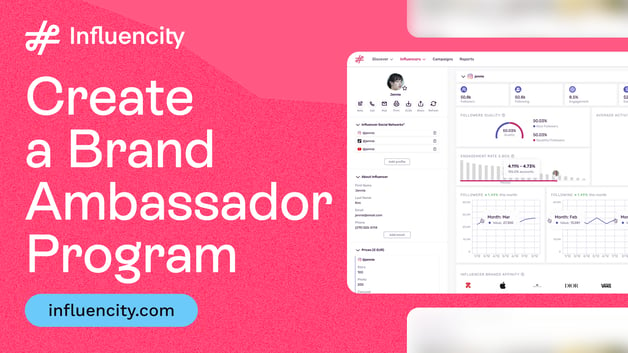In this post, I’ll show you how to use ROI calculators that are built for influencer campaigns, what inputs matter, and how to turn vague results into concrete performance.
someone with a calculator peWhy ROI Is Harder (But More Crucial) in Influencer Marketing
Marketers have been chasing ROI for decades. But in the influencer marketing industry, it’s extra complicated.

That’s because this channel rarely drives a straight, trackable line from post to purchase. Influencers often spark interest at the top of the funnel—long before someone’s ready to buy. One video might lead to a share, which leads to a Google search, which leads to a retargeting click a week later. That’s impact. But it won’t show up if you’re only looking at last-click attribution or promo codes.
Then there’s the issue of misleading metrics. A post can rack up likes without driving a single sale. A creator might deliver sky-high reach but attract the wrong audience entirely. If you’re not measuring the right things, you’re optimizing for the wrong outcomes.
And yet this is exactly why ROI matters so much here. Budgets are tighter. Leadership wants proof. And influencer marketing is now a core part of the media mix. If you want to scale, you need more than just engagement stats. You need numbers that back up the spend.
What ROI Calculators Actually Measure
An ROI calculator is only as good as the inputs you feed it. And in influencer marketing, knowing what to plug in and what you’ll get out is key.
Here’s what most calculators are built to handle:
Inputs:
- Total campaign cost
- Engagement rate
- Conversions
- Average order value (AOV)
- Lifetime value (LTV)
Outputs:
- ROI %
- Customer Acquisition Cost (CAC)
- Incremental Revenue
What ROI calculators don’t show is the full ripple effect of influencer marketing: the long-tail sales, organic shares, lifetime referrals, and the brand equity that builds when trusted creators talk about your product. However, when you need to show short-term performance and justify spend, they give you the clearest snapshot available.
Step-by-Step: How to Use an ROI Calculator for a Real Campaign
Using an ROI calculator isn’t complicated. But you’ll need to think through the inputs and how you will use this tool consistently so your outputs are meaningful over time. Here’s how to do it right, with examples across different campaign types:
1. Define the Campaign Scope
Before you input anything, be clear on what’s included:
- Just the organic post? Or also paid amplification?
- Are you factoring in creator usage rights or whitelisting costs?
- Does the campaign goal include app installs, purchases, or leads?
Example – DTC Product Launch:
Let’s say you’re launching a new skincare product and you partnered with 5 mid-tier creators. Each was paid $1,000, plus your product and shipping costs were $1,000, and you ran $2,000 in paid boost. Total campaign cost: $8,000.
2. Gather Key Inputs
Most calculators will ask for:
- Total campaign cost ($8,000)
- Attributed conversions (e.g., 250 tracked via codes or links)
- AOV or LTV (e.g., $40/order)
Plug those in, and you might see:
- ROI: 25%
- CAC: $32
- Revenue: $10,000
3. Account for the Value ROI Calculators Miss
ROI calculators are great for hard, trackable numbers. But if that’s all you’re reporting, you’re not showing the full value of your work.
Influencer campaigns don’t just generate conversions. They create assets, build visibility, and strengthen your brand in ways that standard ROI formulas miss. And when it’s time for decision-makers to evaluate what’s working, those untracked wins matter.
It’s your job to capture them. Not just to prove your campaign worked—but to protect your budget and earn the next one.
So don’t stop at the ROI number. Complete your reporting by documenting the value your calculator doesn’t capture. These proof points can be the tie-breaker to get buy-in for your next campaign.
What Influencer Marketing ROI Calculators Don’t Measure
Here are five types of value influencer campaigns generate that most ROI calculators miss:

Content reuse: Influencer videos and images can be repurposed in paid ads, emails, landing pages, or product listings—reducing creative costs and extending your brand voice.
Organic lift: The ripple effect of a good campaign often includes shares, earned media, and word-of-mouth buzz that drives visibility beyond the original post.
Audience growth: Campaigns can grow your followers, email subscribers, and site traffic even if they don’t convert right away. Those touchpoints still move people closer to purchase.
Brand equity: Repeated creator partnerships help build familiarity, trust, and credibility, all of which influence future buying decisions, even if they’re not immediate.
Search demand: If you see a spike in branded search volume or direct traffic after a campaign, that’s a sign your influence is spreading—even if it’s not attributed to a specific link.
None of these show up in your ROI formula. But they absolutely show up in your long-term results. Make them part of your post-campaign reporting. Help stakeholders see the full picture, not just the conversions.
Compare ROI Across Campaign Types
Not all influencer campaigns are built to drive the same kind of ROI.
Before you evaluate your numbers, make sure you’re comparing them to the right benchmark. What looks like a low return in one business model might be a big win in another. Here are two examples that show how campaign type, goals, and customer value shape the ROI story:
SaaS Example: Influencer-led webinar
- Cost: $5,000
- 10 converted customers
- LTV: $800
- ROI: 60%
App Install Example: Fitness app
- Cost: $3,500
- 25 paying users at $50 LTV
- ROI: –64% (but long-term recovery possible)

Best ROI Calculators and Tools to Try
The right tool can do the heavy ROI lifting for you, whether you’re managing a test campaign or reporting at scale. Below are some of the most popular options, along with what they’re best suited for. I’ve also added tips on how to choose the right one for your team.
1. Influencity
Best for:
Brands and agencies using a full influencer workflow platform
Why it stands out:
Built-in ROI calculator connected directly to your campaign data
Tracks costs, impressions, engagement, and conversions
Works seamlessly with discovery, outreach, and reporting tools
Ideal if you want everything—from briefing to ROI reporting—in one place
Questions it helps you answer:
Which creators drove the most cost-effective conversions?
What was our CAC and ROI across campaigns?
How does paid amplification affect results?
2. Aspire
Best for:
DTC brands using affiliate links, discount codes, or creator storefronts
Why it stands out:
Strong affiliate tracking features
Tracks promo code redemptions
Great at tying revenue to specific influencers or posts
Lightweight enough for teams that don’t need a full CRM integration
Questions it helps you answer:
Which creator drove the most sales through code redemptions?
What’s the ROI of influencer A vs. influencer B?
What content should we repurpose based on performance?
3. Upfluence
Best for:
SaaS, subscription brands, or any team with a long sales cycle
Why it stands out:
Connects to your CRM and e-commerce platforms (Shopify, WooCommerce, HubSpot, etc.)
Tracks customer lifetime value and repeat purchases
Designed to support always-on influencer programs
Offers influencer outreach and campaign tools, too
Questions it helps you answer:
How much LTV did each influencer generate?
Are our influencer-acquired customers more loyal?
Can we justify longer-term partnerships based on downstream value?
4. DIY Spreadsheet Templates
Not every team is ready for a full platform. If you’re running lean, testing new strategies, or just want to understand the numbers behind your campaigns, a DIY spreadsheet can still give you real clarity. It won’t do the attribution for you, but it will show you where the dollars are going and what’s coming back.
Best for:
Small teams, solo marketers, or anyone running early-stage tests without a full influencer platform.
Why it stands out:
No subscription required—just open Google Sheets or Excel and start plugging in your numbers
Full control over what you track and how you define succes
Easy to customize for your specific goals: product seeding, awareness, affiliate, or lead gen
A great way to learn the mechanics of ROI before committing to a tool
Questions it helps you answer:
Did we break even or generate a return on this campaign?
Which creator’s post brought in the most conversions?
How much did it cost us to acquire each new customer
Are we ready to scale this effort—or do we need to revise our strategy?
What to track manually:
-
Total campaign cost (creator fees + shipping + paid boost)
-
Conversions (via tracked links, promo codes, or post-purchase surveys)
-
AOV or LTV
-
Follower growth or engagement lift (if relevant to goals)
Use these basic formulas:
-
ROI = (Revenue – Cost) ÷ Cost
-
CAC = Cost ÷ Customers Acquired
Beyond the Numbers: How to Interpret ROI Results
Once you have the ROI number, then you have to figure out what it means for your business. Whether your result is good, bad, or somewhere in between depends on your business model, margins, and timeline. A campaign that looks like a loss in DTC might be totally acceptable in SaaS because the value comes in later.
What “Good” ROI Looks Like by Industry
- DTC: 20–30% on first purchase is a healthy range
- SaaS: Break-even is fine if LTV is high
- Apps: May see negative ROI early on with payoff later
When a Low ROI Isn’t a Red Flag
- Influencer content drove new followers
- UGC repurposed into top-performing ads
- Influencers opened a new customer segment
Short-term ROI might lag, but long-term value builds.
What to Optimize
If ROI’s low:
- Were you working with the right creators?
- Was your CTA specific and measurable?
- Did the landing page match the creator’s tone?
ROI is more than a proof point. It is a tool you can use to test, learn, and refine your next campaign.
Final Takeaways: ROI Is a Tool, Not a Finish Line
Influencer marketing isn’t guesswork but it can feel that way without the right tools.
ROI calculators give you a starting point: a clear, measurable look at how your campaigns are performing. They help you prove value, spot inefficiencies, and make smarter decisions about what to scale, tweak, or drop.
But the most successful teams know that ROI isn’t just about one number. It’s about what that number means: what worked, what didn’t, and how to improve the next round.
So whether you’re reporting to your CMO, defending a budget, or trying to grow smarter, not just bigger, the right calculator can help you turn raw campaign data into better campaign outcomes.
Tags:
Influencer Marketing ROI






















%20and%20How%20Can%20They%20Benefit%20Your%20Brand%20article.jpg?length=628&name=What%20Are%20Key%20Opinion%20Leaders%20(KOL)%20and%20How%20Can%20They%20Benefit%20Your%20Brand%20article.jpg)








